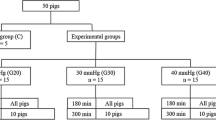Abstract
Background: Minimal invasive surgery is increasingly used in conditions complicated by peritonitis—e.g., peptic ulcer perforation. This study was devised to assess the effect of a pneumoperitoneum (PP) on the ultrastructural integrity of parietal peritoneum in perforation-induced peritonitis.
Methods: Anesthetized rats were subjected either to standardized gastrotomy simulating gastric perforation (groups Ia–d; IIa–d) or to sham perforation (groups IIIa–d, IVa–d). In group I (a–d) and III (a–d), CO2 was insufflated 12 h after gastrotomy for 60 min (Pia 4 mmHg). Glutaraldehyde was administered intraperitoneally at the end of the PP period while the abdominal wall was still extended (group index a), as well as 30 sec (b), 2 h (c), and 12 h (d) after desufflation. Specimens were taken from the parietal peritoneum of the left diaphragm for scanning electronic-microscopic (SEM) analysis. In groups II (a–d) and IV (a–d), simple puncture of the abdominal cavity was performed, and specimens were taken at corresponding times.
Results: In group Ia (gastric perforation with PP), distortion of the mesothelial cell layer with concomittant opening of stomata to the submesothelial tissue was already observed in specimens harvested while the abdominal wall was still extended. Concomitantly, scarce microvilli, which appeared coarse and thickened, were lying flat on top of the mesothelial cells. After desufflation (groups Ib–c), a rapid process of mesothelial disintegration with disruption from the submesothelial layer and vanishing of microvilli occurred. At 12 h after PP (group Id), complete deterioration of mesothelial cell integrity was observed. In groups IIa–c (gastric perforation without PP), microvilli appeared shrunk and coarse, while integrity of the mesothelial cell layer remained intact up to 2 h after the abdominal puncture. At 12 h after abdominal puncture (group IId), the microvilli had nearly completely vanished and the mesothelium was breaking apart into multiple soils.
Conclusions: In SEM analysis of parietal peritoneum, premature distortion, and disintegration of the mesothelial cell layer was observed in animals exposed to increased abdominal pressure in addition to gastric perforation-induced peritonitis.
Similar content being viewed by others
Author information
Authors and Affiliations
Additional information
Received: 4 May 1998/Accepted: 17 November 1998
Rights and permissions
About this article
Cite this article
Bloechle, C., Kluth, D., Holstein, A. et al. A pneumoperitoneum perpetuates severe damage to the ultrastructural integrity of parietal peritoneum in gastric perforation-induced peritonitis in rats. Surg Endosc 13, 683–688 (1999). https://doi.org/10.1007/s004649901073
Published:
Issue Date:
DOI: https://doi.org/10.1007/s004649901073




